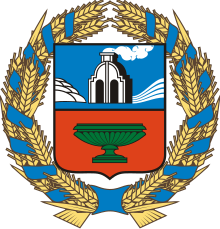Revnev jasper bowl
In the Hermitage in Saint Petersburg there is an oval bowl made of Revnev jasper , which is also called the "Tsarina of bowls" ( Царица ваз , trans. Zaritsa was ). The bowl was made from the world's largest gemstone at the beginning of the 19th century . It was a national symbol in the Russian tsarist empire and the importance of the bowl is still high to this day, its stylized image can also be found in the coat of arms of the Altai region .
meaning
Large polished products made of gemstones and hard stones (for example from the production of the Kolyvan stone cutter, which has existed since 1799 ) are widespread in Russia. The Revnev bowl, which was produced from 1820 to 1843, fulfilled the status of a national symbol for Tsarist Russia.
The exhibition hall, in the middle of which the bowl is located, is part of the “New Hermitage” building. The exhibition site was designed in 1851 based on a design by Leo von Klenze . According to Klenze's plan, the hall was to become the vestibule of the New Hermitage. The hall walls are made of stucco marble and simulate white marble . On and in front of the walls are marble portraits of rulers from the late 1st century to the middle of the 2nd century from Roman antiquity . It is one of the most important collections of Roman portrait art.
The exposed exhibition space and the furnishings make references to the porphyry bowl in Rome and the large granite bowl in the Lustgarten in Berlin . The porphyry bowl originally stood in the Golden House of Nero (37–67 AD) before it was placed in the Sala Rotunda of the Vatican . This selection based on the size of Rome, the reputation of the Roman emperors and the importance of the porphyry material used as a rock used by important people in history, should not be a coincidence.
The Roman porphyry bowl has demonstrably inspired the manufacture of the granite bowl in Berlin as well as that of the Revnev bowl, and the original exhibition location in front of the entrance to the Altes Museum in Berlin was just as exposed as the location in the Hermitage. Both locations of the bowls are museums of great historical importance and the bowls were planned for the respective entrance halls. The King of Prussia understood the granite bowl in the pleasure garden as a national symbol. The same is likely to have applied to the Russian tsars, who particularly distinguished themselves with numerous gifts of bowls and vases made of Revnev jasper and other valuable stones to befriended mansions, who were supposed to demonstrate their size, power and influence not only at home but also abroad .
size
The Russian bowl has a size of 5.04 × 3.22 meters and rests on a base about 2 meters high. The circumference of the bowl is just under 12.7 meters. The entire cultural monument is 2.57 meters high and weighs around 16 tons. It was made according to a design by the architect Avraam Melnikow.
What is remarkable about this bowl is that it was made from the world's largest piece of jasper - a gemstone that is otherwise used to make jewelry. There is no larger bowl made from this gemstone.
Appearance, manufacture and placement
The Revnev jasper ( Russian Ревневская яшма / Revnevskaja jaschma) has a green-gray banded decor that forms a mirror-smooth surface when polished. It has been mined at the foot of the Revnyukha mountain since the 19th century. Not only was the Revnev bowl cut and polished from this stone, but other valuable objects were made that are now in Russian and foreign museums, such as a gift from Tsar Alexander I (1801–1825), which is now in the Louvre .
It is not known in detail how this bowl was made. Since jasper is relatively hard and brittle, it must be assumed that there was a high level of wear on the abrasives and stone cutting tools or that these tools were specially hardened. Because of the oval shape, rotating machine tools could not be used for grinding and polishing. It can therefore be assumed that the bowl was made entirely by hand. This is also indicated by the long production time.
To the place of installation, the Revnev bowl was dragged on a wooden structure by 120 to 160 horses, partly overland, partly by water to Saint Petersburg . The “Tsarina of the Bowls” was placed in the center of the exhibition hall in front of the building's outer walls. The installation of the bowl in the Hermitage required the participation of 720 people.
Individual evidence
- ↑ P. Kolesar, J. Tvrdý: Tsarist treasures. Haltern (Bode Verlag / Edition Schloß Freudenstein) 2006. p. 498; Arnd Peschel: Natural stones. Leipzig (VEB Deutscher Verlag für Grundstofftindustrie) 1977, p. 275.


